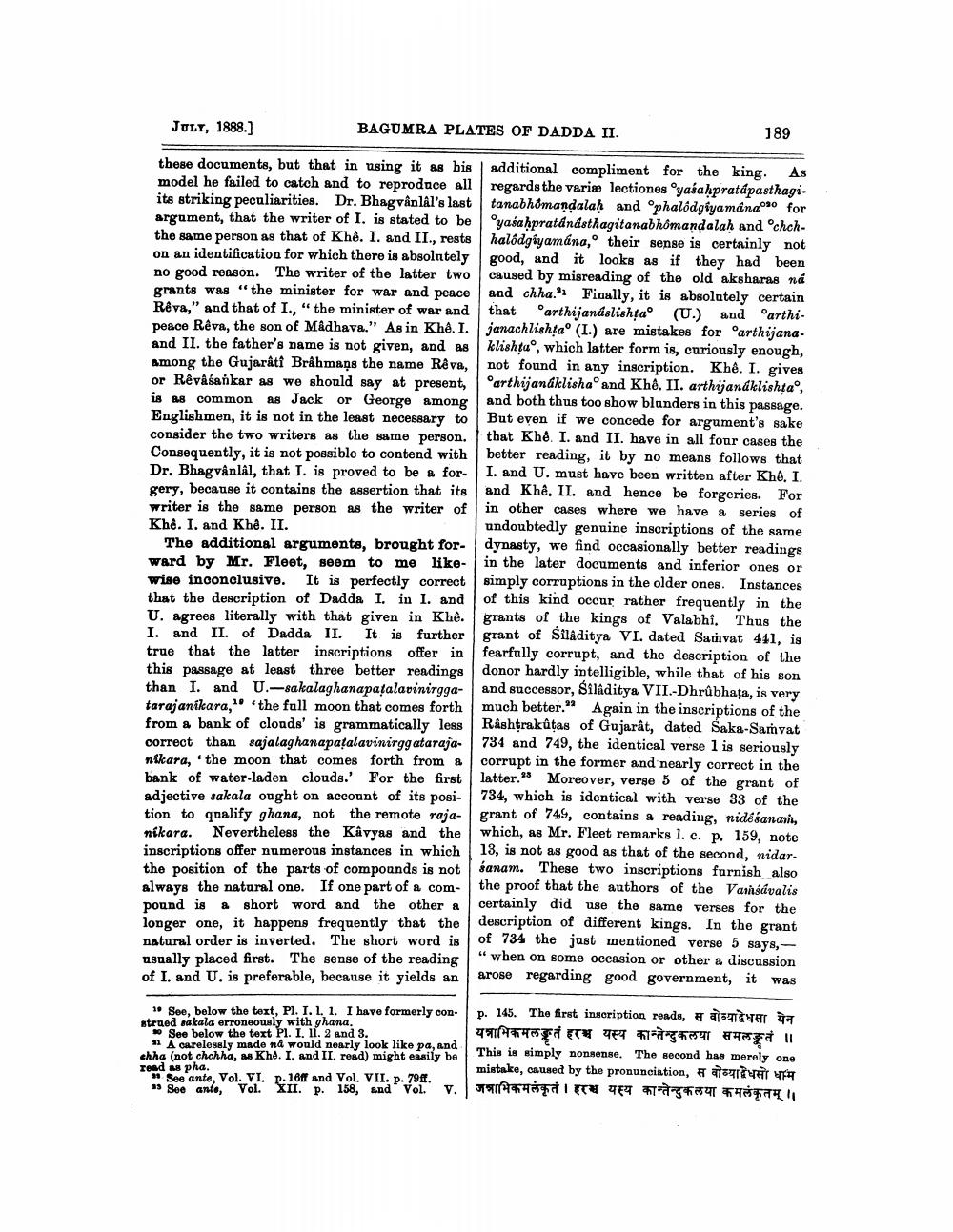________________
JULY, 1888.)
BAGUMRA PLATES OF DADDA II.
189
these documents, but that in using it as his additional compliment for the king. As model he failed to catch and to reproduce all regards the variæ lectiones oyasakpratápasthagiits striking peculiarities. Dr. Bhagvanlal's last tanabhomandalaḥ and ophalodgiyamânao* for argument, that the writer of I. is stated to be yasahpratandsthagitanabhomandalah and ochchthe same person as that of Khê. I. and II, rests halódgiyamána, their sense is certainly not on an identification for which there is absolntely good, and it looks as if they had been no good reason. The writer of the latter two caused by misreading of the old aksharas na grants was "the minister for war and peace and chha." Finally, it is absolutely certain Rêva," and that of I., "the minister of war and that arthijanáslishțao (U.) and arthipeace Rêva, the son of Madhava." As in Khê. I. janachlishtao (I.) are mistakes for 'arthijanaand II. the father's name is not given, and as klishţao, which latter form is, curiously enough, among the Gujarati Brahmaņs the name Rêve, not found in any inscription. Khê. I. gives or Rêvâsankar as we should say at present, arthijandklishaoand Khê. II. arthijandklishta', is as common as Jackor George among
and both thus too show blunders in this passage. Englishmen, it is not in the least necessary to But even if we concede for argument's sake consider the two writers as the same person that Khê. I. and II. have in all four cases the Consequently, it is not possible to contend with better reading, it by no means follows that Dr. Bhagvånlâl, that I. is proved to be a for- I. and U. must have been written after Khê, I. gery, because it contains the assertion that its and Khê. II. and hence be forgeries. For writer is the same person as the writer of in other cases where we have a series of Khê. I. and Khê. II.
undoubtedly genuine inscriptions of the same The additional arguments, brought for dynasty, we find occasionally better readings ward by Mr. Fleet, seem to me like- in the later documents and inferior ones or wise inconclusive. It is perfectly correct simply corruptions in the older ones. Instances that the description of Dadda I. in I. and of this kind occur rather frequently in the U. agrees literally with that given in Khê. | grants of the kings of Valabhi. Thus the I. and II. of Dadda II. It is further grant of Siladitya VI. dated Samvat 441, is true that the latter inscriptions offer in fearfully corrupt, and the description of the this passage at least three better readings donor hardly intelligible, while that of his son than I. and U.-sakalaghanapatalavinirgga- and successor, Silâditya VII-Dhrûbhata, is very tarajanikara, 'the full moon that comes forth much better.” Again in the inscriptions of the from a bank of clouds' is grammatically less Rashtrakūtas of Gujarat, dated Saka-Samvat correct than sajalaghanapatalavinirggataraja- 734 and 749, the identical verse 1 is seriously nikara, the moon that comes forth from a corrupt in the former and nearly correct in the bank of water-laden clouds. For the first latter. Moreover, verse 5 of the grant of adjective sakala ought on account of its posi- 734, which is identical with verse 33 of the tion to qualify ghana, not the remote raja- grant of 745, contains a reading, nidésananit, nikara. Nevertheless the Kavyas and the which, as Mr. Fleet remarks l. c. p. 159, note inscriptions offer numerous instances in which 13, is not as good as that of the second, widar. the position of the parts of compounds is not sanam. These two inscriptions furnish also always the natural one. If one part of a com- the proof that the authors of the Varsávalis pound is a short word and the other a certainly did use the same verses for the longer one, it happens frequently that the description of different kings. In the grant natural order is inverted. The short word is of 734 the just mentioned verse 5 says, usually placed first. The sense of the reading " when on some occasion or other a discussion of I. and U. is preferable, because it yields an arose regarding good government, it was
** Soe, below the text, Pl. I. 1. 1. I have formerly con strued nakala erroneously with ghana.
See below the text ÞI. I. 11. 2 and 3. - A carelessly made nd would nearly look like pa, and chha (not chchha, as Khd. I. and II. read) might easily be road as pha.
See ante, Vol. VI. p. 10ff and Yol VII. p.798. » Soe ante, Vol. XII. p. 158, and Vol. v.
p. 145. The first inscription reads, # T A 47 यत्राभिकमल कृतं हरश्च यस्य कान्तेन्दुकलया समलतं ।। This is simply nonsense. The second has merely one mistake, caused by the pronunciation, a WFA
4 ITU TET GRUT T U




